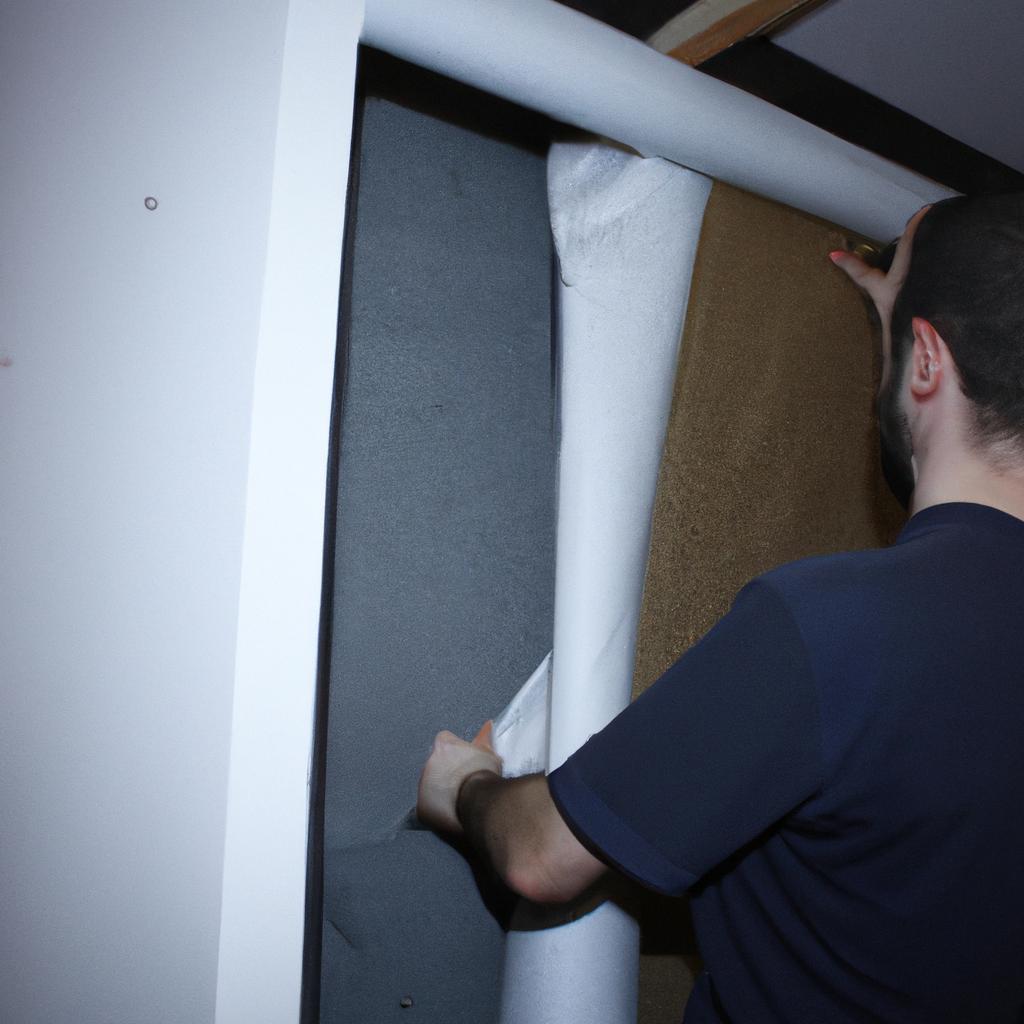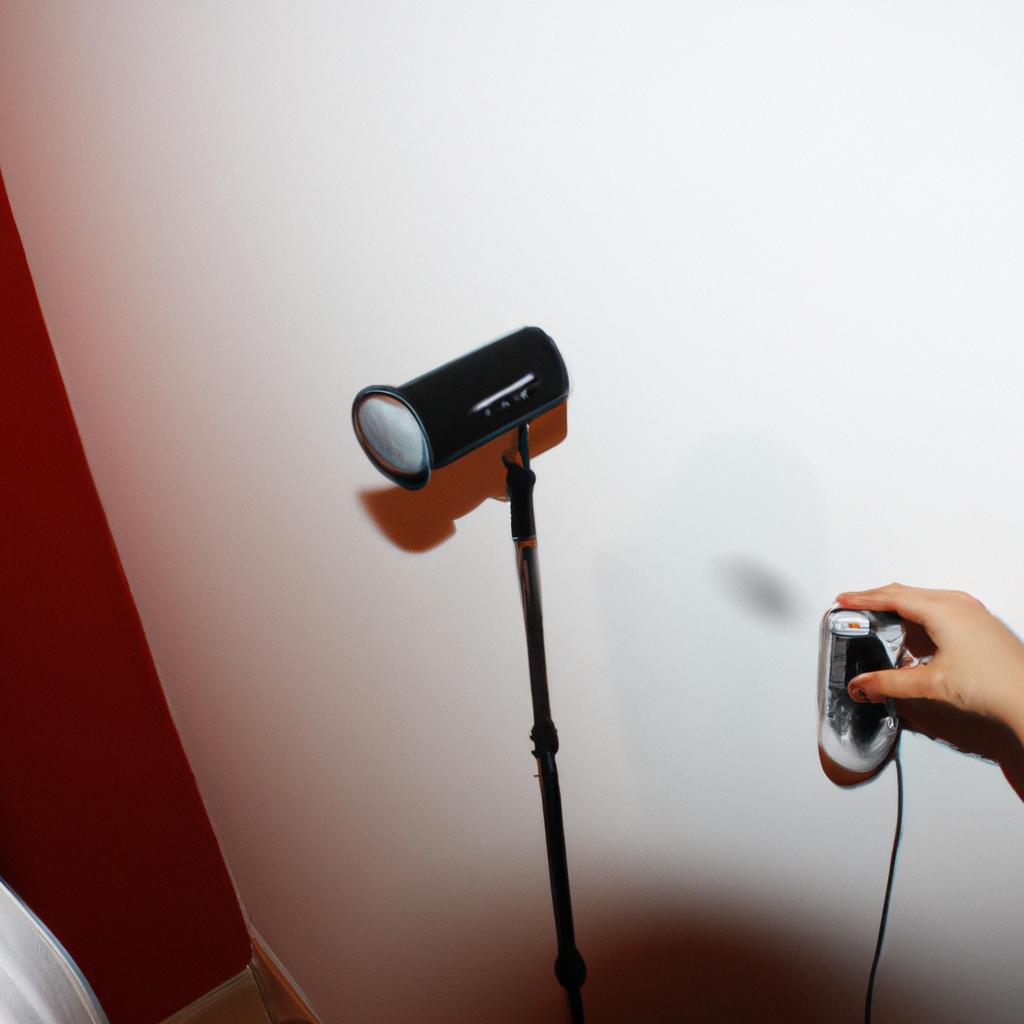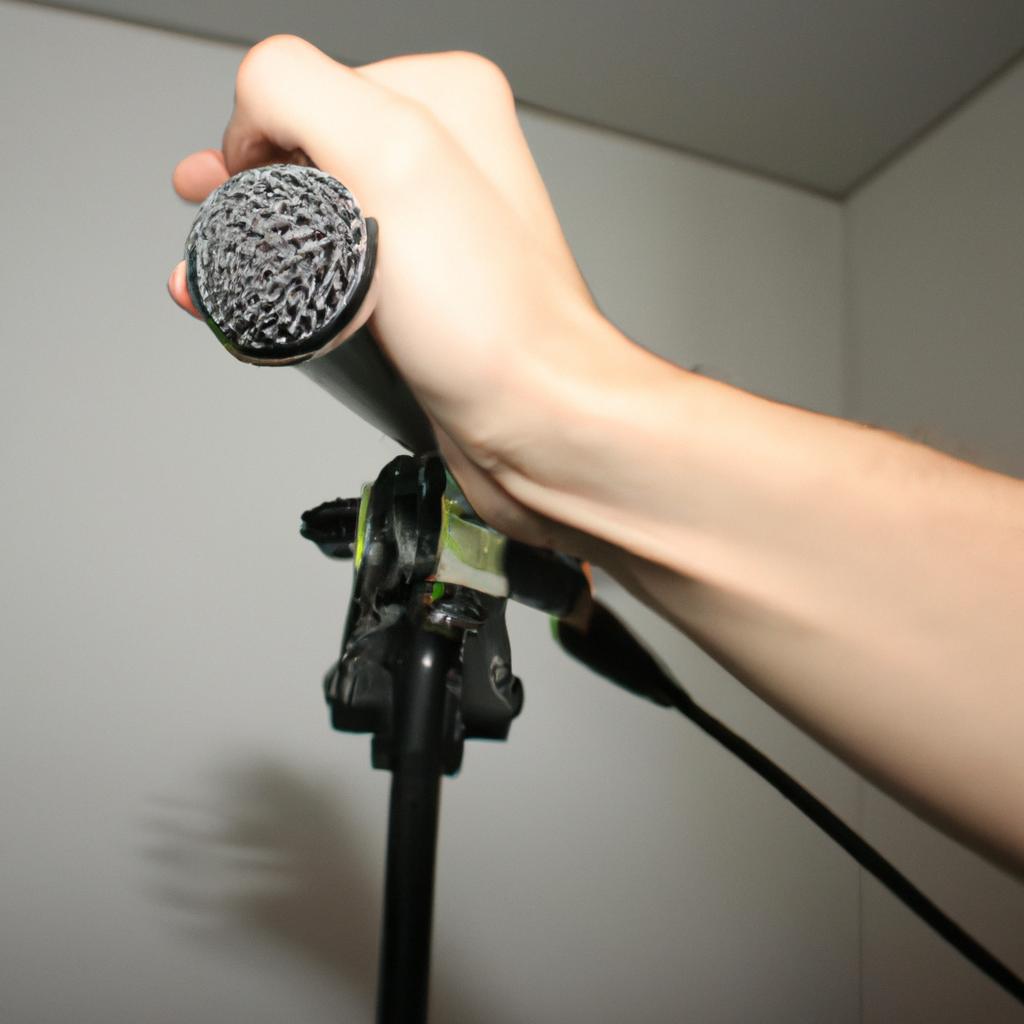The importance of soundproofing in achieving enhanced acoustics cannot be overstated. Whether it is a professional recording studio, home theater, or simply a personal space for enjoying music and movies, the quality of sound reproduction greatly depends on minimizing external noise interference and optimizing room acoustics. To illustrate this point, let us consider a hypothetical scenario where an individual has set up a home recording studio but is constantly plagued by unwanted background sounds such as traffic noise and neighborly disturbances. Despite investing in high-quality audio equipment, these external noises severely impact the overall listening experience, leading to frustration and compromised recordings.
To address such challenges and create an environment conducive to optimal sound performance, effective soundproofing strategies are essential. This guide aims to provide sound and vision enthusiasts with practical insights into various techniques that can be employed to achieve superior acoustic conditions. From analyzing the existing acoustic properties of the space to implementing insulation materials and strategic placement of absorptive panels, attention to detail is crucial in enhancing sound isolation and creating an immersive auditory experience. Furthermore, we will explore innovative technologies such as active noise cancellation systems and advanced room correction software that further contribute to improved acoustical accuracy.
By understanding the principles behind successful soundproofing strategies and applying them judiciously, one can transform any space into a haven for pristine sound reproduction, allowing for the full appreciation of music, movies, and other audio content without the distraction of external noise interference.
Understanding Noise Sources
Understanding Noise Sources
Imagine you are sitting in your living room, enjoying a movie night with your family. As the suspenseful scene unfolds onscreen, an intrusive sound interrupts the immersive experience. Frustrated, you try to identify the source of this disturbance. This scenario highlights the importance of understanding noise sources and finding effective solutions for enhanced acoustics.
To comprehend noise sources better, it is vital to recognize that they can originate from both internal and external factors. Internally generated noises include home appliances, such as refrigerators or air conditioning units, which emit low-frequency vibrations that can disrupt tranquility within a space. External sources encompass environmental sounds like traffic noise, neighborhood activities, or construction work nearby. Identifying these distinct sources helps us target specific areas for improvement when implementing soundproofing strategies.
To further grasp the impact of noise sources on our auditory environment, consider the following bullet-point list:
- Unwanted noise can lead to increased stress levels and decreased productivity.
- Persistent exposure to high-intensity sounds may result in hearing damage over time.
- Disruptive noises can hinder concentration during study or work sessions.
- Sleep disturbances caused by noise pollution can have long-term effects on physical and mental well-being.
As we delve deeper into comprehending different aspects related to soundproofing strategies in subsequent sections, let us examine how various noise sources affect our daily lives through a table:
| Noise Source | Description | Effects |
|---|---|---|
| Traffic | The continuous flow of vehicles on busy roads | Increased stress levels |
| Construction | Heavy machinery used in building projects | Disturbed sleep patterns |
| Neighbors’ Activities | Sounds emanating from neighboring apartments or houses | Reduced focus and productivity |
| Home Appliances | Vibrations produced by household devices like washing machines or air conditioners | Potential hearing damage over time |
Understanding noise sources lays the foundation for implementing effective soundproofing strategies. By recognizing the specific types of sounds that infiltrate our spaces, we can tailor solutions to address these weak points in sound leakage. In the subsequent section, we will explore methods to identify and mitigate such vulnerabilities without compromising on comfort or aesthetic appeal.
Identifying Weak Points in Sound Leakage
Understanding Noise Sources and Identifying Weak Points in Sound Leakage
Now, let’s delve into identifying weak points in sound leakage to help you effectively soundproof your space.
Imagine a scenario where you are trying to create a home theater experience in your living room. You have invested in high-quality speakers and audio equipment, but despite your best efforts, external sounds such as traffic or conversations from neighboring apartments still seep into your entertainment space. This is a common problem faced by many sound enthusiasts, highlighting the importance of addressing weak points in sound leakage.
To assist you further on this journey, here are some key strategies to identify these weak points:
-
Conduct an auditory inspection: Take the time to actively listen for any noticeable gaps or cracks in walls, windows, doors, or ceilings through which unwanted noises may infiltrate. Pay attention to areas near electrical outlets or ventilation systems as they can often be overlooked culprits.
-
Visual examination: Perform a thorough visual inspection of the room and its surroundings. Look for visible signs of wear and tear such as damaged seals around windows or loose fitting doors that may contribute to sound leakage.
-
Seek professional advice: Consider consulting with acoustics experts who can conduct detailed assessments using specialized tools and techniques like decibel meters and infrared cameras to pinpoint specific areas prone to sound leakage.
-
Engage with fellow enthusiasts: Join online forums or communities dedicated to soundproofing and share experiences with others who have tackled similar challenges successfully. Learning from their insights can prove invaluable when it comes to identifying potential weak points.
By incorporating these strategies into your soundproofing endeavors, you will be able to take proactive steps towards enhancing the acoustics within your space. Remember that every situation is unique; hence, adapt these guidelines according to the specifics of your environment.
Moving forward, we will explore the next crucial step in our soundproofing journey: Sealing Gaps and Cracks. With a solid understanding of weak points, we can now proceed to address them effectively, ensuring optimal acoustic isolation for your desired soundscape.
Sealing Gaps and Cracks
Transitioning from our previous discussion on identifying weak points in sound leakage, let us now delve into the crucial step of sealing gaps and cracks. To illustrate the importance of this process, consider the following hypothetical scenario: you have just set up a home theater system in your living room. Excitedly, you start playing your favorite action-packed movie at high volume to fully immerse yourself in the experience. However, as soon as an intense car chase ensues on screen, you realize that the sound is leaking out of your living room and disturbing others in adjacent areas of your house.
To prevent such sound leaks, it is essential to identify all potential gaps and cracks where sound can escape or enter a space. These vulnerable areas include doors, windows, electrical outlets, baseboards, vents, and even ceiling fixtures. By meticulously inspecting these elements for any openings or loose fittings, you can effectively pinpoint the primary sources of sound leakage.
Once identified, it becomes necessary to seal these gaps and cracks using appropriate methods and materials. Here are some strategies worth considering:
- Use acoustic caulk or sealant to fill small gaps around door frames or window casings.
- Install weatherstripping around doors to create a tight seal when closed.
- Apply adhesive-backed foam tape along baseboards or between floorboards to minimize vibrations and reduce air gaps.
- Utilize expanding foam insulation for larger voids around pipes or electrical outlets.
By employing these techniques, you can significantly enhance the overall acoustics within your desired space while also ensuring minimal sound leakage outside. Furthermore, incorporating soundproofing materials during this process will further amplify their effectiveness by attenuating unwanted noise.
Incorporating effective sealing strategies forms an integral part of achieving optimal soundproofing outcomes. In the subsequent section about “Using Soundproofing Materials,” we will explore various materials and their applications in detail, enhancing our understanding of how to create an acoustically controlled environment.
Using Soundproofing Materials
Sealing Gaps and Cracks plays a crucial role in ensuring effective soundproofing. In the previous section, we explored how sealing gaps and cracks can significantly reduce noise transmission between rooms or from external sources. Now, let us delve into another important aspect of soundproofing: using soundproofing materials.
One example that illustrates the importance of utilizing appropriate materials is a home theater setup located within an apartment building. Imagine watching your favorite movie on surround sound speakers, only to be disrupted by the sounds of neighbors above or below you. By employing effective soundproofing techniques such as sealing gaps and cracks with acoustic sealant and installing resilient channel systems, you can create an environment where outside noises are minimized, allowing for enhanced audio experiences.
To achieve effective soundproofing through material usage, consider implementing the following strategies:
- Mass loaded vinyl (MLV): This dense yet flexible material acts as a powerful barrier against airborne noise when installed over walls, ceilings, or floors.
- Acoustic foam panels: These lightweight panels absorb sound waves, reducing echo and reverberation within a room.
- Green Glue compound: Applied between layers of drywall or plywood, this viscoelastic product converts vibrations into heat energy, effectively diminishing sound transmission.
- Sound isolation clips: By decoupling walls from their structural elements using these specially designed clips, impact noise can be significantly reduced.
Table 1 showcases different types of commonly used sound-absorbing materials along with their respective Noise Reduction Coefficient (NRC) ratings:
| Material | NRC Rating |
|---|---|
| Fiberglass | 0.75 |
| Mineral Wool | 0.95 |
| Polyester | 0.70 |
| Polyurethane Foam | 0.80 |
As evident from Table 1’s NRC ratings, mineral wool offers superior absorption capabilities compared to other options listed. However, it is important to consider factors such as cost, availability, and compatibility with your specific soundproofing needs when choosing the most suitable material.
By implementing these strategies and utilizing appropriate materials, one can significantly enhance acoustic performance within a space. In our subsequent section on Creating Soundproofing Structures, we will explore how designing structures that minimize noise transmission can further contribute to achieving optimal soundproofing results.
Creating Soundproofing Structures
Section H2: Using Soundproofing Materials
In the previous section, we discussed various soundproofing materials and their effectiveness in minimizing external noise intrusions. Now, let’s delve deeper into the realm of creating sound barriers to enhance acoustics within a space.
Imagine you’re setting up a home theater system in your living room. You want to enjoy an immersive cinematic experience without disturbing others in adjacent rooms or even neighbors. One effective approach is utilizing multiple layers of sound-absorbing material on walls and ceilings. For instance, consider installing acoustic panels made from high-density foam or fabric-covered fiberglass. These absorbent materials can significantly reduce reverberation and echo while improving overall sound quality.
To further improve the efficiency of your soundproofing strategy, here are some key points to keep in mind:
- Sealing gaps: Pay attention to any gaps or cracks that might allow sound leakage. Use weatherstripping tape around doors and windows, seal electrical outlets with putty pads, and ensure proper insulation around air vents.
- Mass-loaded vinyl (MLV): This specialized barrier material is dense and flexible, making it ideal for reducing airborne noise transmission through walls, floors, or ceilings.
- Double-glazed windows: If outside noise pollution is a concern, opt for double-glazed windows equipped with laminated glass. The additional layer helps minimize incoming sounds.
- Door sweeps: Install door sweeps at the bottom of doors to prevent sound from seeping through gaps between the floor and the door itself.
Consider this hypothetical scenario: You have a music studio located near a busy urban area where traffic noise constantly interferes with your recordings. By applying these strategies along with other customized solutions such as resilient channel systems or decoupling techniques, you can create an environment conducive to capturing pristine audio without disturbances.
| Material | Pros | Cons |
|---|---|---|
| Acoustic panels | Excellent sound absorption properties | Can be expensive |
| Mass-loaded vinyl | Effective at reducing airborne noise transmission | Requires professional installation |
| Double-glazed windows | Significantly reduces outside noise intrusion | Higher cost compared to regular windows |
| Door sweeps | Easy to install and affordable | May require occasional maintenance |
By implementing these soundproofing strategies, you can create an acoustically optimized space that enhances your audio experience while minimizing unwanted disturbances.
Section H2: Creating Soundproofing Structures
Optimizing Room Layout and Design
Now, let’s delve into the practical aspect of creating effective soundproofing structures that can significantly reduce noise transmission.
To exemplify the effectiveness of these strategies, consider a hypothetical scenario where a homeowner resides near a busy highway. The constant traffic noise permeates their living space, causing disturbance and hindering relaxation. By implementing proper soundproofing techniques, such as those outlined below, the homeowner can transform their environment into a peaceful oasis free from external noise pollution.
Firstly, one essential strategy is to insulate walls with high-density materials like mass-loaded vinyl (MLV). MLV acts as a barrier against airborne sounds by absorbing and blocking them from entering or exiting a room. Moreover, including multiple layers of drywall with an air gap in between further enhances acoustic insulation capabilities.
Secondly, addressing flanking paths – alternate routes through which sound waves travel – is crucial for effectively reducing noise transfer. Sealing gaps around doors and windows using weatherstripping tape prevents sound leakage while installing door sweeps ensures no gaps exist at the bottom. Additionally, applying acoustic caulk along baseboards and electrical outlets eliminates potential points of sound escape.
Thirdly, incorporating resilient channel systems aids in minimizing structure-borne vibrations transmitted through ceilings or walls. These channels isolate drywall from structural elements by suspending it using flexible metal strips or clips. This approach disrupts direct contact points that typically facilitate vibrational transfer and significantly improves overall sound isolation.
Finally, utilizing double-glazed windows equipped with laminated glass helps combat external noise intrusion efficiently. Laminated glass consists of two panes bonded together with an interlayer designed to dampen vibrations caused by incoming sound waves. This feature not only reduces noise penetration but also offers additional benefits such as improved thermal insulation and increased security.
By adopting these soundproofing strategies, individuals can create a serene acoustic environment within their homes or workplaces. The table below summarizes the key points discussed in this section and emphasizes the significant impact of effective soundproofing on enhancing overall auditory experiences.
| Soundproofing Strategies | Benefits |
|---|---|
| Insulate walls with MLV and multiple layers of drywall | Absorbs and blocks airborne sounds effectively |
| Seal gaps around doors, windows, baseboards, and electrical outlets | Prevents sound leakage through flanking paths |
| Install resilient channel systems to isolate drywall from structural elements | Minimizes structure-borne vibrations |
| Utilize double-glazed windows with laminated glass | Reduces external noise intrusion while providing additional benefits |
Incorporating these soundproofing techniques into your architectural design ensures optimal acoustics by minimizing unwanted noise transmission. Achieving an environment free from disruptive sounds enhances concentration levels, promotes relaxation, and ultimately contributes to a sense of well-being for all occupants.











